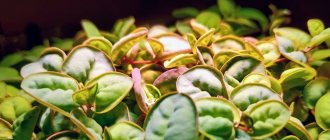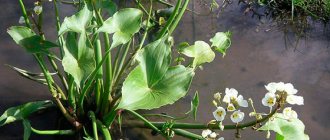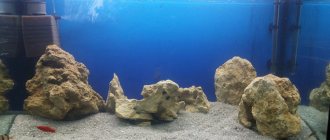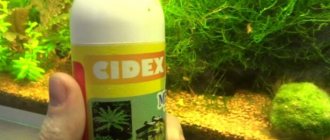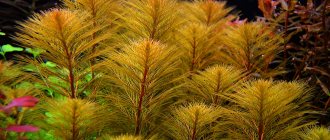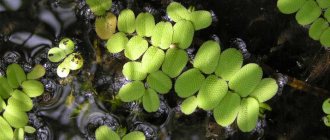Small duckweed (Lemna mínor).
The duckweed family is Lemnoideae .
The entire plant is used for medicinal purposes.
Grows in stagnant waters. Found in Western and Eastern Siberia, the Caucasus, Central Asia, and the Far East; throughout Europe and Asia, in China, Japan and Mongolia.
Small duckweed is a perennial plant that has a very simplified structure: it is not divided into stems and leaves, but is a small green leaf-shaped body, the so-called “leaf” - the upper part of the plant, floating on the surface of the water and similar to small buttons, dark green in color , size in diameter: 1/2 - 1 cm, roots extend down in the form of short and thin icicles that do not reach the bottom and extract nutritional juices from the water.
Where does duckweed grow and what does it look like?
This grass is found in any stagnant bodies of water, especially with a variety of organic living creatures that provide duckweed with nutrition. Thin leaf plates float on the surface of the water. The roots extending from them, acting as a keel, are under water. Depending on the type of duckweed, the leaf has a different shape and size. A small inflorescence may appear at its base.
In the autumn, when the temperature drops to +6 degrees, the grass prepares for the formation of future sprouts, forming special buds. Then it sinks to the bottom, where it remains until spring.
The plant is very unpretentious and is characterized by rapid growth, especially in polluted water. Able to tolerate very low temperatures and difficult climatic conditions, but prefers temperate and tropical climates.
Medicinal recipes from duckweed
The medicinal properties of the plant are manifested in anticarcinogenic activity.
The herb can be used to make tablets. They are made from the dried plant, ground into powder and mixed with honey. You should take one or two tablets three times a day.
To prepare the juice, pass the duckweed grass through a meat grinder and squeeze. Then it should be mixed with honey or sugar in a 1:1 ratio. The juice is stored in a loosely closed container.
To prepare a decoction, add 500 ml of water to one tablespoon of herb. Bring to a boil and let sit for five minutes.
To prepare the tincture, pour one tablespoon of duckweed into one glass of vodka. Infuse for three weeks in a tightly closed container.
Common types of duckweed
There are many species of this flowering plant, but all of them float freely in the water column or on its surface. Good lighting contributes to the formation of a vast accumulation of rafts, like a carpet covering the surface of the water. The so-called light filter cleans the pond, enriching it with oxygen and protecting it from flowering.
A change in leaf shade indicates the presence of pollutants.
Annual tropical duckweed
L. aequinoctialis. The only species that belongs to annual plants. The length of the leaf plates is greater than the width. Characterized by fairly frequent flowering. Prefers to settle in stagnant bodies of water, completely covering their surface.
Photo gallery
Small duckweed (swamp)
L. minor. The perennial plant has small green leaves floating on the water (up to 15 mm). The rarely appearing flowers are also very tiny. Appears only in fresh water (small lakes, ponds, swamps).
Duckweed trilobed
Lemna trisulca. It is found in stagnant waters of the temperate climate zone . It is located in the water column, forming deep openwork thickets, rising only during flowering. Aquarium fish prefer to live among the thin light green leaves.
Common polygonum (Duckweed polyradica)
L. polyrhiza (Spirodela polyrhyza). From each plate comes not one, but a bunch of thread-like reddish or white roots. The small leaves with a purple back are round in shape and up to 6 mm in diameter.
Winter grass: application
Wintergreen is used for weight loss. It will not help you dramatically lose weight, but you can still use it to lose 2-3 kilograms per month. Weight loss occurs due to:
- normalization and restoration of metabolic processes;
- improving the digestion process;
- removal of toxins and waste;
- slight decrease in appetite;
- diuretic effect.
Wintergreen tincture
The herb also prevents the absorption of fats and sugars from food, accelerates the process of fat breakdown, and improves immunity.
Attention! You shouldn’t get too carried away with the boletus. It greatly removes fluid from the body, and with it potassium.
How to collect, dry and store duckweed
All parts of the plant are harvested for medicinal purposes, and only environmentally friendly places are chosen for this. The harvesting process is carried out in the summer using a net. Then the raw materials must be spread in a thin layer on a cloth in a place protected from the sun and mixed periodically. Drying in a well-ventilated area is allowed . After drying, the grass crumbles easily.
To store raw materials, you should use carefully sealed containers, for example, glass jars, which should be located in a place protected from sunlight. The shelf life of dry herb is 1 year.
Types and preparation
[turbobutton]
The grass is easily propagated vegetatively. It can survive any weather conditions and even the coldest winter. It is small, blooms very rarely, but multiplies quickly. The most popular are 2 types of this perennial:
- Small duckweed (swamp). It is popularly used to treat various diseases. It has antipyretic, anti-inflammatory, choleretic, analgesic and other properties. Thanks to its chemical composition, which includes iodine, the perennial is used to prevent thyroid diseases and diabetes.
- Duckweed is three-lobed. Widely distributed in water bodies. Often used in aquariums. Known for its diuretic properties.
The duckweed plant is popularly known for its healing properties.
It is worth noting that this perennial has a number of contraindications for use:
- vegetative-vascular dystonia;
- various nervous diseases;
- individual intolerance.
As already mentioned, duckweed grows near bodies of water. However, not every body of water can collect grass for treatment. The water in which grass grows must be environmentally friendly. It should also not be inhabited by waterfowl. Having taken the plant out of the water, it is laid out in the sun and dried well. It should be stirred regularly during the drying process. The finished raw material is very fragile and crumbles easily. It is poured into a glass jar and stored in a cool, dark place. Maximum shelf life is 1 year.
Medicinal properties and chemical composition of duckweed
The grass is rich in chemical composition, namely:
- microelements;
- proteins;
- fats;
- fiber;
- flavonoids;
- triterpene compounds.
The amount of protein contained is comparable to that of legume leaves, and its nutritional properties are not inferior to cultivated cereals. The amount of amino acids (arginine, lysine) even exceeds their content in corn.
The effect of the elements on the body has an astringent, antipyretic, diuretic and antispasmodic effect. Remedies containing duckweed are used as anti-cold, tonic, hemostatic, anthelmintic and choleretic agents.
In medicine, water infusions are actively used to treat diseases, such as:
- scurvy;
- allergy;
- hives;
- erysipelas;
- ulcers and boils;
- conjunctivitis;
- respiratory tract pathologies;
- joint diseases;
- haemorrhoids.
Due to its ability to cope with skin diseases, the aqueous product is in particular demand among dermatologists.
The healing power of duckweed
The medicinal properties of duckweed are noted in his works by the famous botanist A.I. Schröter. The scientist carefully studied the healer's recipes and found a scientific basis for them. They noticed that the plant has anti-inflammatory, analgesic, as well as diuretic and choleretic properties.
During research, flavonoids and terpene compounds were identified in duck grass. This combination usually provides a pronounced antimutagenic effect. This made it possible to claim that duckweed has anti-cancer effects.
Application area of duckweed
This unique plant is used in several ways:
- In homeopathy.
- In agriculture (food additive for animals and birds).
- As a component in the manufacture of medications used to enhance immune strength and in dermatology.
The plant is used for the production of decoctions, alcohol or water infusions. Actively used in home therapy.
Beneficial features
This plant contains:
- amino acids (including essential ones: lysine, arginine);
- proteins;
- vitamins A, B and E;
- tannins;
- flavonoids;
- polysaccharides;
- micro- and macroelements;
- minerals (iodine, bromine, phosphorus, calcium, etc.);
- organic acids.
The unusual composition determines the healing properties. First of all, it is worth highlighting the presence of protein, which makes duckweed very nutritious. The following effects of duckweed on the human body have been observed:
- choleretic;
- bactericidal;
- anthelmintic (anthelminthic);
- pain reliever;
- anti-inflammatory;
- antipyretic;
- anticancer;
- antifungal.
It has been noticed that a small amount of duckweed in food, literally a pinch in porridge or soup, helps in the growth and development of children. It is also beneficial for pregnant mothers and healthy fetal development. During breastfeeding, the quantity and nutritional properties of milk increase, and duckweed is harmless and does not harm the body, of course, if consumed in reasonable quantities.
Duckweed is also used as a soil fertilizer due to the presence of minerals. This is a good tool for enriching reservoirs with oxygen, which duckweed synthesizes, which is actively used in home aquariums. It is popularly called “water lentil” due to its high protein content (about 40-50% after drying).
Duckweed in folk medicine
People have been using algae for economic and medicinal purposes since ancient times, and quite widely. It has been noted that the plant has a positive effect in the fight against malignant tumors , allergic reactions, diseases of internal organs, purulent wounds and other ailments.
Decoctions
For external use, decoctions are prepared, which are used to wash poorly healing wounds, purulent formations, and are also used for respiratory diseases.
To prepare the decoction yourself, you need to take 1 tbsp. spoon of dry product and pour a glass of water. Then bring to a boil and remove from the stove. After an hour, filter the solution. The dishes must be enameled. You should consume half a glass before meals 4 times a day. Children are allowed to use the decoction only from the age of 1 year. The dose for a child is 1 tbsp. spoon 3 times a day.
How to collect duckweed (video)
Alcohol tincture
The product, prepared on an alcohol-containing basis, is used in the treatment of tonsillitis, and is also used as painkillers. External use eliminates skin itching and swelling.
To prepare the tincture, pour 1 teaspoon of fresh raw materials into a glass of vodka or 40% alcohol. It is advisable to use a dark glass container. After 7–8 days, the composition must be filtered and drunk 20 drops mixed in a quarter glass 3 times a day.
Duckweed infusion with honey
Honey infusion is used in the fight against vitiligo and other skin ailments. The duckweed needs to be crushed and the juice squeezed out using gauze and combined with honey in equal proportions. The medicine should be taken 1 teaspoon three times a day. For storage, the infusion should be placed in a place with low temperature.
Honey balls with duckweed
Dried raw materials must be ground to a powder and combined with honey. Then roll into pea-sized balls. To ensure that the balls keep their shape, it is better to use candied honey. You should take from 1 to 3 pieces per day. Despite the fact that treatment with honey is very long, it leads to positive results. The medicine should be used by people suffering from anemia, prostatitis, and also for the prevention of colds. Experts recommend consuming peas in winter and spring.
Use for diseases
According to doctors F.I. Ibragimov and V.S. Ibragimova, duckweed contains protein, iodine and bromine. It is used as an antipyretic and desensitizing agent, reducing the body’s sensitivity to the effects of various substances intolerable to organisms. It is useful for urticaria, edema (of nervous origin), for vitiligo, that is, a disease expressed in whitish-milky spots that appear on the skin, for gout, rheumatism, as a diuretic and as one of the means of combating glaucoma.
Traditional medicine uses duckweed primarily for the treatment of vitiligo. This plant is also used to treat skin diseases with an allergic component (exudative-catarrhal diathesis, neurodermatitis, urticaria). Duckweed infusion is used to wash purulent wounds and ulcers.
An infusion of small duckweed is taken orally for chronic rhinitis, laryngitis, bronchitis, liver diseases, glaucoma and rheumatism. It is taken orally as a remedy for psoriasis.
Contraindications and harm of duckweed
The plant is a non-toxic product, so people tolerate it well and get a lasting effect. Duckweed-based products are contraindicated in case of individual intolerance to the components included in its composition, as well as in patients with nervous disorders, otherwise causeless irritability, a serious nervous breakdown or hysteria may occur. Patients with vegetative dystonia are also advised to stop eating duckweed.
When using the product, it is important to ensure that it does not lead to an overdose, and also not to use it very often. In this case, sleep disturbance, increased irritability and excitability are possible. It is necessary to stop using medications.
What does duckweed contain?
The plant contains many beneficial substances for the human body. Therefore, duck grass is in demand in folk medicine. Some medicinal properties of the plant have been evaluated by pharmacologists.
Thus, on the basis of duckweed, the drug “Vitilem+” was created, intended for the treatment of vitiligo. Duckweed is rich in the following substances:
Eating practices
Wolffia arrhiza, one of the representatives of the Duckweed family, has long been used as food by the population of Burma, Laos and Thailand. In Thailand they call it khai-nam (“water eggs”). The low distribution of this plant in the diet of other countries is explained by the presence of crystallized oxalic acid, which spoils the taste. In addition, under natural conditions, many pathogenic microorganisms coexist with this plant, which are difficult to separate.
Indian carp (Catla catla) 1.5 kg each. Fed exclusively on duckweed (photo PRISM).
Tilapia on a diet with duckweed and auxiliary feed (Bangladesh). Duckweed was grown on sewage.
As food, duckweed is most common in fish farming. It can be added fresh or mixed with other components. The fresh plant is suitable for feeding to herbivores and omnivores, especially grass carp (Ctenopharyngodon idella), silver barb (Puntius gonionotus) and tilapia (Oreochromis). Channel catfish were successfully raised on a diet with duckweed, but this feeding technology was not commercially used.
The culture can be bred separately from the fish and then added as food, or in the same pond with the fish. Growing it in one pond is ineffective. Strong aeration, which is practiced, in particular, when cultivating catfish, disrupts the development of duckweed. The photosynthetic activity of the plant is not associated with the enrichment of water with oxygen, and, in fact, its dense cover reduces gas exchange with the atmosphere (Landolt and Kandeler, 1987, p 387).
Duckweed Pond (www.engr.ncsu.edu)
Successful cultivation of members of the Lemnaceae family requires experience. Achieving high productivity requires a precise balance between crop density, feeding and fertilization, and sufficient oxygen for the fish.
Although feeding duckweed exclusively is possible, this plant is low in carbohydrates. Therefore, it is often mixed with a carbohydrate source component, in a ratio of 50-60 to 40-50%.
In addition, Hassan and Edwards (1992) noted a decrease in fat content in tilapia fed a duckweed diet. This plant has been shown to be low in fat (3-5% of dry weight). The study authors suggested using an energy-rich source such as rice bran.
With an average feed conversion factor of 2.5 on a duckweed diet and its growth of 20 tons/ha per year, 8 tons/ha per year of fish can be obtained (Gijzen and Khondker 1997). This theoretical estimate is comparable to actual data obtained for Asian semi-intensive carp farms (2-8 tonnes/ha per year, Skillicorn et al. 1993).
It has been reported that the smallest species of Wolffia, Wolffiella and Lemna are used as food for fry and fingerlings. For example, in China, the parasitic prevalence of Wolffia and Lemna species allows them to be used as food for young-of-the-year grass carp (Edwards 1990).
Cassani and Caton (1983) studied the growth characteristics of hybrid carp to determine food preferences and feed intake. Hybrids of grass carp (Ctenopharyngodon idella, Val.) with bighead carp (Hypophthalmichthys (Aristichthys) nobilis Rich), aged 12-18 months, were used. The authors concluded that among the six duckweed species, fish prefer the humpback duckweed (Lemna gibba). Moreover, preferences do not change when grown in two different temperature ranges (12-15 C and 25-28 C). Based on the time of complete consumption and the relative amount of duckweed eaten, the authors concluded that preferences were the same. The average daily biomass consumption of Lemna gibba at 25-31 C was 178 grams per fish.
Gaigher et al (1984) compared the growth of hybrid tilapia (Oreochromis niloticus X O. aureus) on a diet containing commercial pellets and duckweed. Individuals were reared at high densities in an experimental recirculating system for up to 89 days. They were fed duckweed (Lemna gibba) or a mixture of duckweed and commercial pellets. The authors concluded that the best growth rates were observed in the group of fish that were fed a mixture of pellets and duckweed.
On the duckweed-only diet, there was low feed utilization, relatively poor growth (0.67% of body weight daily) and a feed conversion ratio of 1:1. Only 65% of the consumed duckweed was eaten by fish and 26% was converted into their mass and absorbed. When diets included commercial pellets and duckweed, duckweed intake was reduced and fish growth rates doubled at a feed conversion ratio of 1:1.2-1.8. 70% of the diet was consumed and only 21% was absorbed. On the mixed feed, the fish had similar growth as on exclusively commercial pellets, but had a better feed conversion factor.
Botanical description and natural habitat
Duckweed (Lemna) belongs to the Araceae family. It is a perennial aquatic monocotyledonous plant, except for one species - tropical. The name comes from the Russian word ryasy, which meant beads. These are microscopic plants that move on the surface of stagnant waters and form real settlements. They are classified as plankton. They are found in nature in swamps, lakes, natural and decorative ponds and do not live in fast river water. The growth rate is high, it is quite difficult to remove, so there is a comparison with weeds. It will not be possible to divide Duckweed into a leaf and a stem. Its body looks like an oval or elongated plate (leaf); at the bottom there may or may not be an almost transparent root, on the side there are branches that grow and separate. This is how reproduction occurs.
Veins (5-7) with a number of air sinuses (1-2) and a barely noticeable root help the plant to stay on the water. The plates are pale greenish in color, dense. Their bottoms are smooth, shiny, yellow or white, sometimes with red splashes. Small, inconspicuous flowers, usually light or lemon, appear quite rarely. The fruit resembles a bag in appearance; its seed ripens inside, but with its help Duckweed does not reproduce.
The optimal temperature for development is +20…+28 °C, but can grow at +6…+33 °C. A distinctive feature is that it survives at low temperatures, under ice.
The entire plant may freeze, but it will form viable buds (turion buds), which will begin a new development cycle in the spring. It tolerates unfavorable conditions at the bottom of the reservoir, where it sinks due to the high starch content. It has received popular nicknames “frog sack” and “duck grass” because waterfowl love to eat it.
Duckweed can be found in almost all countries of the world, except the Arctic. It prefers warm and humid climates, but also grows in the temperate zone. She ended up there thanks to birds and animals, sticking to their limbs and thus moving over long distances.


